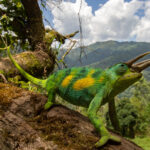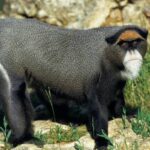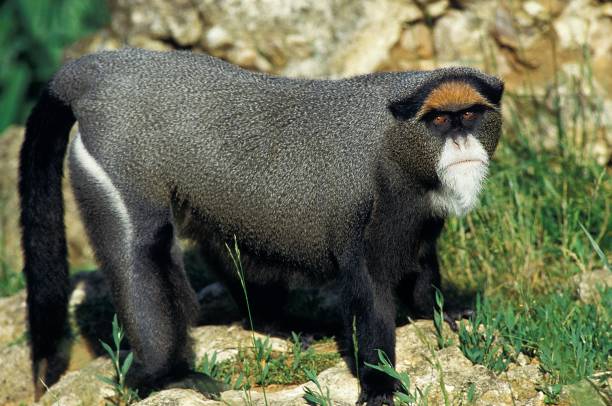The De Brazza’s monkey in uganda are some of the most interesting wildlife in the world in found in dense forests of uganda, is among the rare and elusive monkey we have in uganda. The uniqueness of its face and shy nature makes it a very captivating discovery for any nature lover touring Uganda’s` rich ecosystems. We shall cover in this article all the information one needs to know about De Brazza’s monkey; distribution, way of living, interesting life cycle and efforts taken toward securing their future.
De brazes monkeys are medium sized primates and have a grey brown coat with a white beard and white brow stripe giving them almost a wise, and grandfatherly appearance. The males are bigger than the females; the males weigh about 7 to 11 kg while the females weigh about 4 to 6 kg. Their bushy tails help them with balance and with calm, deliberate steps they move along through Uganda’s dense forests, where the dark olive-toned fur of their bodies merges into an effective camouflage.
Uganda offers some of the excellent sport of the De brazes monkey despite they are wider distributed across central and East Africa, one may always enjoy seeing the primates in their nature setting some of these places include;
The De brazes monkey are found in Semuliki national park in the western border of uganda and DR Congo , this lowland tropical rainforest gives way to an advanced ecosystem that supports many kinds of wildlife. The abundance of trees and the quiet less frequented nature of the park make it very suitable for those who would wish to spot these shy animals.
They also seen in Mabira forest, this is the biggest rainforest in Uganda and it is relatively close to Kampala. Several primate species inhibit in this forest, such as the red tailed monkeys, baboon vevart monkeys among others.
The De-Brazza’s monkey is also found in eastern part of Uganda in the Mount. Elgon national park, the topography and vegetation make it ideal for these monkeys. The park has dense montane forests that give them the suitable nature they love while a number of rivers and streams supply their need of food water.
De brazes monkeys are quiet and reserved never aggressive, they are found in small family group composed of a dominant male, a number of females and their young ones. Members have different vocalizations, facial expressions and body postures that may convey a number of messages to members within the group.
Their diet is essentially frugivorous since a large bulk of their consists of fruits. However they are opportunity feeders and will also eat leaves, flowers, and seeds and sometimes eat small insects. One of the reasons they thrive from riverside swamps to dense forest is due to the adaptability in their diet.
De Brazza`s monkeys have a lifespan of 20years in the wild but they live a little longer in captivity, with less threat from predators and environmental factors sometimes living up to 30 years. This makes them one of the primate species in the cercopithecus family- a group including other forest monkeys such as the blue monkey have relatively long lives.
They tend to have rather close-knit relationships in their groupings with long lifetime, an older family member might well live through several generations of births, helping to raise and socialize younger monkeys. In family groups where is a male is often the single and dominant male may stay protecting of the group for many years.
The gestation period of De Brazza`s monkey is about 5 to 6 months, female monkeys typically give birth to one baby but some twins are shown still rare in these monkeys. Babies arrive with soft black fur and a small version of the iconic white bread that makes these monkeys so recognizable. The rarely heavily their mothers in the first few months of life often stages close for carrying and nursing.
Within a few months the infants start to go out on their own independently but the always remain within a very close to the mother for protection. These stages in their lives are really important as they learn vital social techniques that will benefit them in highly density forests.
There is some tips to spot the De Brazza’s monkeys that is the professional guide who will know where exactly to go and when, knows their behaviors here you will be having high chances of finding them.
These monkey needs someone to be patient because they are more sensitive to noise and tiniest disturbance may be enough for them to vanish into the leaves.
Like going for bird watching also theses monkeys needs binoculars with you because they like concealing themselves in tall and high trees and in dense bushes they can be spotted with the help of binoculars even from a distance.
Focus in areas where next to the water sources like rivers, one should look for any movement either in the canopy or in the shrubs.
Generally early morning hours of the day are some of the greatest moments for viewing animals, this is because at this time of the day, temperatures are cooler and usually animals tend to be very active looking for food before they go to rest in noon time.
Mirama hills safaris is adding you De Brazza`s monkey in your safari itinerary which is offers you a great opportunities for viewing one of Uganda’s more behaviors offer a nice contrast loud and energetic primates such chimps.
The De Brazza’s monkeys are as mystifying as Uganda’s mountain gorillas yet not as popular. They are just as mesmerizing for those who look for them. It is a gratifying experience to come across one in the wild. The experience that demands patience, respect and a keen eye to spot the monkeys. These forests are a haven for both De Brazza`s monkey and a myriad of other species as Uganda continues to enhance the growth of conservation development.








